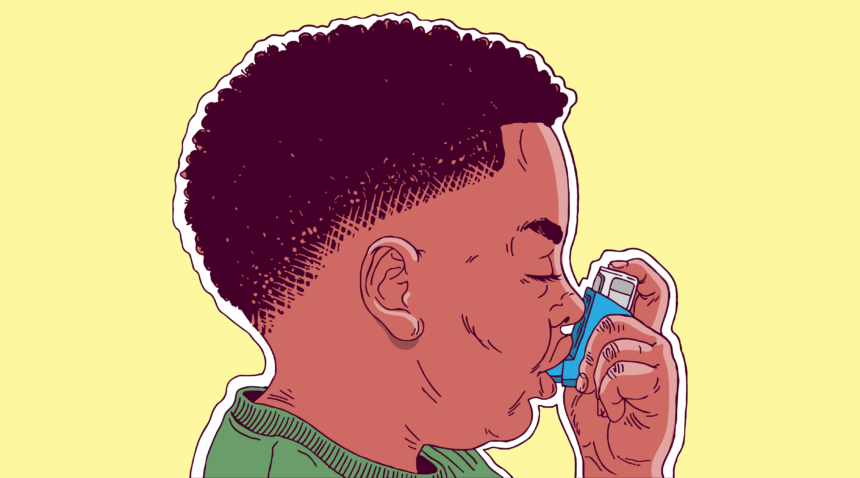It’s very frightening to realize that your child might be struggling to breathe. That’s why it’s good for parents to know what to do in advance. Minor breathing problems are common throughout life, but serious breathing problems need immediate medical attention.
First: If your child cannot breathe or is in distress trying to breathe, call 911. A lack of oxygen can become serious, even deadly, in minutes.
If your child is struggling to get a full breath, “call your pediatrician, even if it’s the middle of the night,” says UNC Health pediatrician Edward M. Pickens, MD. After office hours, there will be a pediatrician on call who can help you immediately.
Thankfully, most breathing problems are not life-threatening, but they are uncomfortable. Here’s what parents should know to help alleviate that discomfort.
Causes of Breathing Problems in Children
Most breathing problems in children are acute viral infections that will appear for a short time and go away on their own, Dr. Pickens says. This includes cold viruses, RSV (respiratory syncytial virus) and an infection called croup, which affects the throat and vocal cords and causes a barking cough. Children also can have bronchitis, sinus infections and pneumonia.
Notably, coronavirus disease 2019 (COVID-19) can cause shortness of breath in both children and adults.
Some children have chronic conditions that cause breathing problems, Dr. Pickens says. The most prevalent is asthma, which affects about 7.5 percent of children. In rare cases, breathing trouble can indicate a congenital heart problem or cystic fibrosis. Some infants with acid reflux may have trouble breathing.
And of course, choking on a foreign object or food can cause immediate and life-threatening breathing trouble.
Signs a Baby or Child Is Having Trouble Breathing
How you’ll determine whether your child is struggling to breathe will depend on your child’s age. Elementary school-age children can tell you that they’re having difficulty or that their chest hurts. Preschoolers may become noticeably less active.
Babies and toddlers can’t tell you where it hurts, but they are likely to eat less because it’s difficult for them to breathe and eat at the same time. Babies breathe more rapidly than adults normally, so don’t be alarmed if their pace is faster than yours; it’s about noticing their pattern changing, Dr. Pickens says. You also may see flaring nostrils or sucking in around the rib cage; the baby might grunt.
“A lot of it is based on how they look,” Dr. Pickens says. “Do they look happy? Are they eating? Is their breathing different than normal?”
No matter the child’s age, coughing usually accompanies breathing difficulties, Dr. Pickens says.
As for knowing whether it’s an emergency, there are some telltale signs, Dr. Pickens says: a look of panic, which even a young baby will have if unable to breathe, or a color change, where the skin becomes suddenly pale or blue.
You also can tell a lot from the noises your child is making—or not. Wheezing is a major symptom of asthma, especially if it’s recurring. If it’s a one-time thing, or if you hear a whistling sound when your child breathes in, that could indicate he or she has inhaled a foreign object, such as a coin or bead. That is an emergency that needs to be treated immediately, Dr. Pickens says.
That said, making any noise is much better than not being able to make a sound at all, he adds. “A child who can make a noise or who can speak doesn’t have a complete airway obstruction.”
Helping a Child with a Breathing Problem
If you are questioning the cause of your child’s breathing problem, contact your pediatrician. If you don’t want to go into the office, a virtual visit will often suffice.
“If I can take a look at a child breathing over video, that tells me a whole lot,” Dr. Pickens says.
In the vast majority of cases, children with viral infections can recover at home. Parents can make them more comfortable using a cool-mist humidifier or taking them outside into cool air, a particularly useful strategy for relieving the labored breathing of croup, Dr. Pickens says. It also may be easier for them to breathe sitting up than lying down.
Over-the-counter medicated topical rubs work for only short periods, Dr. Pickens says, and should not be used on very young children. Follow the label’s instructions.
Occasionally, doctors will prescribe antibiotics to clear up bacterial infections or steroids to shrink swelling in the throat and lungs, Dr. Pickens says. Children with asthma and those suffering from severe cases of some acute infections may take medications through a nebulizer or an inhaler, devices that turn medicines into mist to inhale.
In severe cases of RSV and croup, children may be hospitalized and given supplemental oxygen, Dr. Pickens says.
“Ninety-nine percent of kids” will get better at home without any intervention, he says, but it’s important to be vigilant because breathing problems can get worse. Parents and caregivers should know how to provide lifesaving CPR if their child stops breathing and the Heimlich maneuver if the child is choking.
If you have concerns about your child’s health, call your pediatrician. Need a pediatrician? Find one near you.

